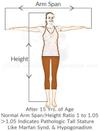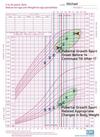Increased Arm Span To Height Ratio
by Michael
(Russia)

Arm Span To Height Ratio
I measured my arm-span, quite accidentally about a year ago at 22 years of age, to see if it fits the formula “arm-span to height as 1:1”. It did not. It was good 6 cm more than my height (176 cm of arm-span to 169-170 cm of height).
Then, in April this year I had muscle pain, especially in my arms. The pain was of moderate intensity and felt as if someone was pulling the arms hard. It lasted for about a week. During the same week, I felt febrile but no other symptoms: no cough, no rhinitis...just a little higher body temperature (37,2-37,4 degrees).
After this episode, I measured my arm-span again and found that it had increased by 2 cm. but the height remained constant (arm-span is 178 cm. and height 170 cm.)
At the age of 14 years I was diagnosed to have delayed growth and sexual development.
Given below is my growth chart (by year):
13.02.07 - 28kg/129cm (9 years and 9 months)
06.05.08 - 31/136 (10 years and 12 months)
28.04.09 - 32/139 (11 years and 11 months)
18.11.10 - 36,7/146 (13 years and 5 months)
28.04.11 - 37/148,5 (13 years and 11 months)
01.10.11 - 40/153,5 (14 years and 5 months)
28.02.12 - 45/157 (14 years and 9 months)
20.09.12 - 47/163 (15 years and 4 months)
27.08.14 - 57/168 (17 years and 3 months)
Both my parents are about 170 cm, but I have tall relatives from my mother side.
Recently, I also calculated my upper and lower limits of heights in the app for spirometry. The calculations there using an arm-span of individual. The app showed my Predicted Height to be 175,9 cm. (upper limit: 182,7 cm, lower limit: 169,7 cm).
Are these calculations right Doc?
If yes, does it mean that my full height could be about 183 cm, but I have only reached my lower limits? I am currently 23 years old. I know that this site works only with newborns and teenagers, but I am asking for your help anyway. – Thanks.
The Expert, Ren Chats Answers
The arm span grows proportionally more than stature in children until only up to 10 years in boys and 12 years in girls. In some normal teenagers arm span may continue to grow proportionally more than stature until about the age 15 years in girls and 25 years in boys, but not more than 5 cm.
Increased arm span to height ratio indicates abnormal tall stature. Arm span that exceeds height by more than 5 cm is typical of Marfan Syndrome and demands detailed medical evaluation.
The two measurements taken at the age of 22 and 23 show an increase of 2 cm in the arm span with no corresponding height gain. No doubt, it is normal for the height gain to stop by the age of 21. But then, the length of arms should not have continued to increase either. Nevertheless, considering that arm span includes chest width, the relatively increase in the arm span could be attributed to broadening of the chest.
In a normal and healthy individual, the proportion of arm length and chest is constant throughout growing years, with no perceivable effect of puberty. This signifies the importance of arm span in growth assessment of children with abnormal short and tall stature.
The predicted height of 175,9 cm by the spirometry app basically indicates stature for arm span of 178 cm. The result confirms that the arm span to height ratio of 178/170 is greater than normal. It is otherwise irrelevant for the diagnosis of the cause of tall stature (see Fig. Causes of Abnormal Tall Stature).
Midparental height (MPH)
MPH does not define genetic potential of an individual. The formula gives only a rough estimate of the expected adult height. It cannot be used to identify or eliminate stature disorder. Having said that, based on MPH formula, a daughter of both partners of height 170 cm. would grow up to be 168.75 cm. tall, and their mature son would be 171.25 cm. tall. But the genetic height range of these offspring could be anywhere from minus 3.5 to plus 3.5 of the calculated mid parental height.
Thus, the measurements of arm span 178 cm. with height of 170 cm. indicate growth disorder. The height gain, if any, could have been lost in scoliosis, an abnormal sideways curvature of the spine, also commonly seen in cases of Marfan syndrome. This could be cross checked by determining upper to lower segment ratio. It is one of the important body proportions to differentiate normal growth variations from growth disorder. The lower segment much greater than the upper segment indicates Marfan Syndrome.
Marfan syndrome is a genetic disorder. It is commonly considered in a young, tall person with thin body and long limbs. These individuals have narrow hands with long slender fingers.
Your growth chart, depicted from the parameters given by you, does not indicate any delay in growth or pubertal growth spurt (see Fig. Effect Of Pubertal Growth Spurt On Growth Velocity). The corresponding weight gain is within the normal limits. It also tallies with the age at which you probably got your menarche.
Delayed sexual development
The age at which the early signs of sexual maturity are noticeable is highly variable. In thin girls it is further difficult to appreciate unless and until a proper physical examination is done by a doctor qualified in the field.
Neither the great growth spurt of puberty nor sexual development is affected in cases of Marfan syndrome. On the contrary, the menarche is a year or two early in these children as compared to the general population.
Arm pain
Moderate pain in the arms with low grade fever could be an episode of tendonitis. Tendons connect muscles to the bones. Inflammation or soreness of tendons however mild would cause pain on slightest use of the muscles. It usually is a result of overuse such as seen in cases of tennis elbow but could be an after effect of an injury as well.
Pressure on the nerve could also cause pain, but in these cases the pain is more sever and is accompanied by tingling numbness as seen in Carpal Tunnel Syndrome or Thoracic Outlet Syndrome.
Related pages of interest:
Short Arm Span in a 9 Year Old
Comments for Increased Arm Span To Height Ratio
|
||
|
||
|
||
Liked what you read just now? Pay it forward!














